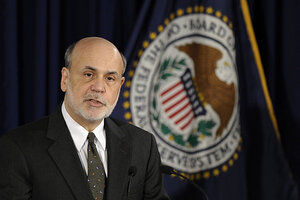Tapering? Maybe later, says Fed.
Fed chief Bernanke spooks the markets with comments that Fed's bond-buying could slow later this year. Dow drops, housing and jobless claims rise – this week in the economy.

Federal Reserve Chairman Ben Bernanke speaks during a news conference in Washington Wednesday. Mixed signals from the Federal Reserve have rattled investors for weeks. When Mr. Bernanke tried to set the record straight – suggesting the potential for shrinking the Fed's bond-buying program later this year if the economy continues to improve – the Dow plunged 353 points.
Susan Walsh/AP/File
No taper … yet: The Federal Reserve released its statement from the May Federal Open Market Committee Wednesday, and Fed chief Ben Bernanke indicated that the central bank wouldn’t change its monetary policy of buying up bonds to keep interest rates low. At least not yet.
But Mr. Bernanke did hint that tapering could be on the horizon. He said bond buying could begin to slow later this year, and, if the unemployment rate falls below 7 percent, end entirely by mid-2014. Interest rates, Bernanke said, will stay low until the unemployment rate falls below 6.5 percent.
“The Fed sent more tapering signals than we anticipated for this meeting,” Paul Edelstein, director of financial economics for IHS Global Insight, wrote in an e-mailed analysis. “But we maintain that the Fed is too optimistic on unemployment, and continue to believe that it won’t taper until 2014. Of course, this view is predicated on progress in the labor market. If the unemployment rate declines enough over the summer, we would likely expect a tapering as early as September.“
Bernanke's comments sent Wall Street into a tailspin, sending the Dow tumbling 353 points for its worst one-day loss of the year.
New home construction, builder sentiment improve: Builders are starting to fall in line with the rest of the economy. Housing starts rose 6.8 percent in May to an annualized rate of 914,000. That’s a 28.6 percent increase from a year ago, but the figure still fell short of analysts’ expectations (a 950,000 annualized rate). Much of the gain was due to multifamily starts, which surged 21.6 percent on the month. (Month to month changes can be volatile: In April, multifamily starts dropped by 32.2 percent).
A combination of factors, including price acceleration, low mortgage rates, and consumer demand mean the improvement will probably continue. Construction industry optimism is at its highest level in years: The index of home builder sentiment from the National Association of Home Builders reached 52 in June, an eight-point gain from May and its highest reading since May 2006.
Existing home sales jump, again: In other housing news, sales of existing homes rose 4.2 percent to a 5.18 million annualized rate in May, reaching its highest level since November 2009. The increase was entirely in the single-family sector, which jumped 5 percent while condo/co-op sales fell 1.7 percent. Home inventory increased 3.3 percent nationwide, but the supply of available homes remained relatively tight. Prices, too, continue to accelerate, with the median price for a single family home up 15.4 percent from a year ago.
Continued steady improvement in the sector is no surprise at this point, but “this was an unexpectedly strong report,” IHS Global Insight economist Patrick Newport wrote in an e-mailed analysis. “At this stage of the business cycle, this is good news. Higher home prices are bringing more home builders onto the market and boosting household wealth. A buildup this size in such a short period is unprecedented.”
Jobless claims tick up: The number of people applying for unemployment benefits rose by 18,000 to 354,000 last week, according to the Labor Department. The rise was more than predicted, but analysts expect no change in the general trend of a slowly improving US job market. ”Although the June data were somewhat softer than observed in May, trends in initial claims remain consistent with an ongoing moderate improvement in labor market conditions,” Barclays Research economist Michael Gapen wrote in his analysis of the numbers.

